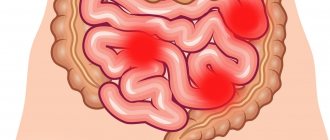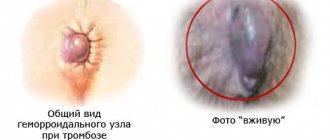What is atonic constipation
Any type of constipation is a sign that intestinal activity is weakened, or there are some general problems with the body.
The main cause of atonic constipation is a decrease in the natural tone of the smooth muscles of the intestine, due to disturbances in the peristalsis of the large intestine.
The muscular tissues of the intestines will not be able to function properly.
Atonic constipation, if noticed in time, will not be a problem. And it can be easily eliminated without resorting to hospitalization.
Atonic and spastic constipation: causes and methods of treatment
Almost every person has difficulties with bowel movements. They are characterized by the absence of bowel movements for more than a couple of days. There are two types of this problem - atonic and spastic constipation. They have their own reasons for their appearance, therefore, therapy should be carried out differently.
What are the differences between the diseases?
atonic constipation is a pathology that is caused by the lack of intestinal motility, as a result of which smooth muscle compression does not occur. Because of this, feces stop moving. with this type of problem there is no discomfort in the abdomen, and the person does not have the urge to stool.
Spastic constipation is a disease caused by excessive tension in the intestinal muscles. this leads to the appearance of strong spasms that hold feces, preventing them from leaving the body. this leads to the formation of fecal plugs. With this type of pathology, the patient experiences increased gas formation and pain in the abdomen.
This is the difference between atonic and spastic diseases.
causes
Causes of atonic constipation:
- age-related changes;
- lack of balanced nutrition;
- malfunction of the body due to low physical activity.
Causes of spastic constipation:
- unstable emotional background;
- diseases of the endocrine system;
- diabetes mellitus of any type;
- deterioration of ovarian function in women;
- insufficiency of the medullary appendage;
- intoxication;
- allergy;
- gastrointestinal pathologies.
Signs
Symptoms of atonic constipation:
- feeling of abdominal distension;
- feces come out slowly with traces of blood;
- headache;
- loss of appetite;
- fatigue even after a long rest;
- unpleasant odor from the mouth;
- white rash on the tongue;
- depressed mood.
Symptoms of spastic constipation:
- bloating;
- inability to have a bowel movement for a couple of days or more;
- feces come out with traces of mucus;
- chronic fatigue even after a long rest;
- increased gas formation;
- irritability;
- stomach ache.
Difficulty with bowel movements in childhood
Spastic constipation may also appear in a child. Causes of the problem:
- transition from breast milk to adapted milk formulas;
- start of complementary feeding;
- excessive consumption of chocolate, sweets and other sweet foods;
- unstable emotional background.
Treatment of diseases in children is recommended using traditional medicine. They are safer for the child than traditional drugs containing chemical compounds. The effectiveness of treatment depends on the emotional state of the child or teenager. Stress and overwork should not be allowed. A comfortable psychological atmosphere should be maintained at home.
Traditional methods of therapy
Folk remedies for constipation that act quickly and effectively:
- Mint infusion. A small spoon of mint is steamed with hot water. Recommended serving: 250 ml. The medicine is left to infuse for 15 minutes. Drink consumption is tied to food. Drink the product before meals twice a day.
- Dill based product. 20 grams of seeds are poured with hot water (a glass) and left for a quarter of an hour. When the time is up, the product is filtered and drunk before breakfast and dinner in equal portions.
- Flax seed drink. A large spoon of the product is placed in a thermos and brewed with boiling water in an amount of 300 ml. The product is kept for half an hour and passed through cheesecloth. Drink 125 ml between doses at least four times a day.
- Collection of medicinal herbs No. 1. To prepare the preparation, you need one part of wormwood and two parts each of horsetail and yarrow. The rights are connected and crushed. 50 grams are separated from the resulting mass and placed in a thermos. The herbal mixture is poured with 500 ml of boiling water and left to infuse for two hours. Over time, the infusion is passed through two-layer gauze. Use half a glass with meals.
- Collection of medicinal herbs No. 2. To prepare the medicine, take 3 parts of St. John's wort, sage and plantain, 2 parts of marsh cudweed and 1 part of mint. The herbs are crushed and one tablespoon is separated from the total mass. Add a glass of boiling water to the mixture. Infusion time is 15 minutes. After this, the infusion is filtered. It is recommended to use 100 ml. Frequency: three times a day.
When problems with stool arise, you cannot ignore them. This condition can cause serious consequences, so it should not be ignored and at the first symptoms you should visit a specialist.
Source: https://zaporinfo.ru/vidy-zaporov/atonicheskij-i-spasticheskij-zapor/
Symptoms
When people have periodic problems with bowel movements, symptoms of atonic constipation will be a response.
Not only the intestines, but the entire body can react.
The condition of atonic constipation is characterized by loss of appetite in humans.
As for the immediate symptoms, they will manifest themselves in the following moments:
- accumulation of significant feces;
- rare bowel movements;
- bloating;
- straining during bowel movements;
- feeling of fullness;
- dense stool structure and large diameter of stool;
- dry stool;
- cracks and tears in the anal mucosa;
- blood in stool.
These symptoms are characteristic of intestinal symptoms. As for the general manifestations, the patient is irritated and lethargic, and there is a general deterioration in health.
There are advanced conditions when toxic decomposition of feces occurs. Possible deterioration of skin condition, fever and frequent headaches.
Causes
The pathogenesis of the pathology is not based on exit obstruction typical of other forms, since feces as such do not block the intestine. In this case, due to various motility disorders and the prolonged presence of feces in the intestine, their final volume decreases, which leads to a rare urge to defecate. The main reasons are presented in the table.
| View | Characteristic diseases |
| Primary constipation | Anomalies and malformations of the intestine, as a result of which the evacuation of contents is disrupted (slowed down): 1. Dolichosigma, dolichocolon, megacolon - an abnormal enlargement of sections of the intestine, which leads to retention of intestinal contents at one of the levels (transverse, colon, sigmoid). 2. Payr's syndrome. Associated with the high location of the splenic flexure of the colon under the diaphragm. This causes retention of gases and intestinal contents. 3. Hilayditi syndrome. Associated with the high location of the bend of the colon (from the side of the liver). The symptoms are similar to Payr's syndrome, but the clinical picture takes a little longer to develop. 4. Hirschsprung's disease. Associated with impaired innervation in the area of the colon. We are talking about complete atony (immobility) along some part of the colon. In this case, the overlying sections are stretched due to overflow with feces. |
| Secondary constipation (symptomatic) | The disorders are associated with a number of diseases, one of the symptoms of which is weakened motility of the large intestine: 1. Damage to the rectum at any interval (anal fissure, hemorrhoids). 2. Endocrine system disorders (diabetes mellitus, hypothyroidism). 3. Neurological disorders such as multiple sclerosis. This also includes constipation resulting from spinal cord injury at the lumbar level. 4. Taking a number of medications (anticonvulsants, iron supplements). 5. Intoxication associated with the characteristics of the profession (intoxication with heavy metals in miners). 6. Constipation during pregnancy (simultaneous action of progesterone and mechanical pressure on the intestines). 7. Eating disorders (reducing the volume of food, excessive consumption of protein foods, fasting, sudden changes in diet). 8. Mechanical compression of the intestine by various formations as a result of adhesions or spastic processes. |
| Idiopathic constipation | It has no established cause (the examination results do not reveal the anatomical substrate of the disease). |
Predisposing factors:
- bad habits;
- emotional disorders (depression);
- dehydration.
Atonic constipation is characterized by an idiopathic nature. It is extremely rare that it is based on other factors, and in this case, constipation is considered more likely to be part of the underlying disease, rather than a separate nosological form.
Causes
To successfully combat atonic constipation, it is important to understand what causes it. Only then can you successfully select a therapeutic complex that will guarantee complete recovery. Among the most common causes of the disease are:
- lack of any physical activity;
- constant consumption of the same food;
- non-compliance or violation of diet;
- consumption of drinking water with a high content of lime;
- insufficient fluid intake daily;
- the presence of inflammatory processes;
- exhaustion caused by excessive exercise;
- ulcers and erosions in the gastrointestinal tract;
- regular stress;
- consequences of surgical invasions in the gastrointestinal tract;
- toxic poisoning;
- disorders in the endocrine system.
The listed reasons are considered by experts to be the main ones. However, there are a number of others that, although considered minor, influence the development of the disease. The cause may be dehydration, drug abuse, alcohol and tobacco.
Atonic constipation can be avoided during exhausting diets, when a person consumes food in volumes below the minimum.
What is the difference between atonic and spastic constipation and how to treat them
Constipation is a condition in which there is no bowel movement for several days. Pathology can be caused by various diseases associated with the functioning of the gastrointestinal tract.
The patient may be diagnosed with atonic constipation and spastic constipation, depending on the clinical picture present. In the first of these types of disorders, intestinal motility is absent. His smooth muscles do not contract.
With spastic constipation, the condition is caused by muscle contractions. Any of the pathologies requires immediate treatment.
Constipation can occur in a person for various reasons.
general information
Constipation is a disorder in which there is no bowel movement for more than two days. The process of defecation is accompanied by significant difficulty. Normally, stool should be daily. The consistency of fecal matter is soft. In the absence of disease, feces are neither solid nor liquid.
With constipation, the patient experiences a feeling of incomplete emptying of the intestinal tract. This is not an independent disease, but just a symptom of some abnormality. Therefore, the pathology requires complex treatment.
The characteristic features of spastic and chronic atonic constipation are described in the table.
| Spasmodic acute constipation | The stool is divided into fragments and resembles that of a goat. The patient complains of significant bloating. Spastic pain in the abdominal cavity. There is a decrease in performance. Feces move slowly through the intestinal tract. The patient feels constant fatigue. |
| Atonic chronic constipation | Fecal masses are characterized by abundance. The first portion of feces is much larger and denser than the last. During the process of defecation, the patient feels severe discomfort. Pain during bowel movements can be unbearable. Due to the large volume of fecal matter, there is a high risk of anal tearing. Sometimes there may be blood in the stool. |
Intestinal spasms and spastic constipation are usually short-term disorders. As a rule, the deviation is not associated with serious illnesses and does not require long-term treatment. Sometimes constipation occurs due to uncontrolled contractions of the intestines
The atonic type of constipation occurs in a chronic form. Difficulty in defecation is long-lasting and painful. The condition requires immediate treatment.
Factors provoking the violation
The root causes differ for different types of deviation. Spastic acute constipation is a consequence of increased intestinal tone. Muscle spasms appear. Feces are unable to move towards the exit. The reasons for the violation include:
- hormonal imbalances in the body;
- elevated blood sugar levels;
- deviation of ovarian function in women;
- psycho-emotional stress;
- IBS;
Problems with stool may occur due to elevated blood sugar levels
- neurological colitis;
- individual intolerance to something;
- intoxication of the body due to consumption of low-quality food, exposure to large quantities of alcohol-containing drinks and contact with harmful chemicals.
The fight against atonic long-term constipation is more difficult. Usually the disorder is characterized by a chronic course. Treatment can only be complex. A doctor's consultation is required. Self-medication is strictly contraindicated. Doctors consider the main provoking factors to be:
- lack of physical activity for a long period of time;
- poor diet and constant consumption of the same foods;
- constant violation of diet;
- drinking low quality drinking water;
Drinking little can lead to constipation
- non-compliance with drinking regime;
- the presence of inflammatory processes in the body;
- exhaustion of the body due to regular excessive stress;
- ulcerative and erosive lesions of the gastrointestinal mucosa;
- regular depression and emotional outbursts;
- recent surgery on the gastrointestinal tract;
- toxic intoxication;
- disruption of the functioning of the endocrine system.
Depending on the factor provoking the disorder, treatment is selected.
It is impossible to independently determine why atonic or, conversely, spastic constipation occurred. It is required to resort to complex diagnostics.
To find the cause of the problem, you need to be examined by a doctor.
Associated symptoms
Symptoms of the spastic type of constipation are less pronounced. The main signs of deviation include:
- colic and painful sensation in the lower abdomen;
- difficulty in defecation;
- the presence of foreign mucous inclusions in fecal matter;
- decreased appetite;
- painful sensation in the head;
- decreased performance;
- outbursts of aggression.
The doctor resorts to palpation. In this way, in case of spastic deviation, painful areas are identified. When violated, the feces are similar to sheep.
With atonic constipation, severe headaches are often observed
The symptoms of atonic constipation are more extensive. The patient complains of general weakness. Performance rapidly decreases, and the patient develops apathy. Headaches become chronic. The skin becomes dry and begins to peel. Dizziness is occasionally present.
With a long course of atonic deviation, a dense coating appears on the tongue. A pronounced and unpleasant symptom occurs in the oral cavity. The heart rate increases and there is pain in the heart area.
The fecal matter is copious and sausage-shaped. The initial portion is dense and has clear boundaries, and the final portion is semi-formed. There is usually a small amount of blood in the stool. The act of defecation is accompanied by unbearable pain.
Possible bad breath
With atonic constipation, there is a painful, aching sensation in the abdomen. There is a bursting feeling in the abdominal cavity. The intensity of symptoms gradually increases.
Treatment measures
Treatment depends on the type of constipation and the cause of the abnormality. The therapeutic course is selected by the doctor after receiving the diagnostic results. The patient is first given a referral to:
- examination of the internal intestinal cavity;
- rectal examination;
- radiography.
Additional symptoms may be prescribed depending on the clinical picture. That is, the treatment of spastic and atonic constipation is complex.
Treatment of constipation consists of changing the diet, taking medications and using traditional methods. The patient must carefully follow all the doctor's recommendations.
People suffering from constipation may benefit from eating more vegetables.
Nutritional Features
Diet for constipation is the first thing you need to resort to if you want to eliminate the problem. It is required to give preference to foods of plant origin. Food should have a uniform consistency. The products are first ground using a blender.
Sugar is replaced with honey. Treatment of spastic constipation is characterized by the need to consume sufficient amounts of fat. You are allowed to drink homemade juices, compotes, herbal teas and still mineral water.
It is necessary to completely exclude from the diet:
- fatty foods;
- food that has a low temperature;
- baking;
- sausages;
Sweets and baked goods should be completely avoided
- various preserves and marinades;
- spicy foods and foods with a lot of seasonings;
- rice porridge;
- confectionery;
- mushrooms;
- alcoholic drinks;
- salty snacks;
- cocoa.
The diet must include liquid foods at least once a day. The diet for the spastic type of pathology or atonic constipation is no different. It is important to exclude all harmful foods.
This video will help you normalize your stool:
Drug treatment
To treat atonic and spastic constipation, the patient is prescribed the following laxative medications:
- osmotic drugs;
- medications that stimulate the functioning of the intestines, irritating effects;
- lubricating drugs.
In addition, the patient is recommended to take probiotics and prokinetics. Medicines help restore intestinal motility and restore the natural microflora of the body. Food begins to be digested normally. The condition of the gastrointestinal mucosa is normalized.
Probiotics can help relieve constipation
In the treatment of atonic and spastic constipation, choleretic drugs are recommended. Thanks to this, the process of digesting food improves. The content moves smoothly to the output.
In the atonic form of constipation, the patient is advised to take hemostatic drugs. Medicines are necessary if there is blood in the feces.
Traditional methods of treatment
Complex treatment of atonic and spastic constipation includes the use of traditional therapeutic methods. Plantain seeds are highly effective. They are first crushed and consumed 1 tbsp. l. before bedtime.
An effective folk method - vegetable oil on an empty stomach
After waking up, it is recommended to drink a tablespoon of vegetable oil. The component is washed down with a glass of water. This must be done on an empty stomach. Positive dynamics will appear after a few hours.
Prunes are highly effective. 2 tbsp. l. dried plums are poured with 250 ml of boiling water. Infuse the drink for two hours. Drink 125 ml twice a day.
Before using any traditional methods, you should consult a doctor. Otherwise, there is a high risk of an allergic reaction.
Preventive measures
The spastic and atonic type of constipation causes significant discomfort. Only by following preventive measures can you significantly reduce the risk of developing a deviation. First of all, doctors recommend that patients take daily walks.
To prevent constipation from bothering you again in the future, try not to overindulge in fried and fatty foods.
It is important to stop drinking alcoholic beverages. Limit consumption:
- foods with a lot of carbohydrates;
- fat;
- fried;
- acute.
The diet should include as many fruits and vegetables as possible. Fiber helps the intestines function properly. You are also required to consume fermented milk products every day.
Source: https://kishechnik.guru/zabolevaniya/prochie-bolezni/atonicheskij-i-spasticheskij-zapor.html
Treatment of atonic constipation
There are several options for treating atonic constipation. Each of them is capable of creating a tangible effect and leading to certain results. Before choosing a specific therapy, you should always consult with an appropriate specialist.
Drug treatment
Currently, drug treatment is prescribed only in cases where atonic constipation does not go away over a long period of time. For abdominal pain, various drugs belonging to the group of antispasmodics are prescribed. If constipation occurs too often, laxatives are used.
Among these drugs, the most often prescribed are:
Bisacodyl Regulax
Castor oil
If the question arises whether it is possible to drink Duphalac for atonic constipation, then you must remember that the drug also belongs to the group of laxatives.
In the treatment of atonic constipation, drugs whose action is aimed at enhancing peristalsis are very effective. Examples include prozerin, ganaton, and montana.
In cases where there are significant difficulties with bowel movements, the doctor prescribes special rectal glycerin suppositories. The purpose of candles is to evoke the urge to defecate.
Diets
Click to enlarge the image
Diet for atonic constipation is one of the most effective methods of treatment. At the first signs of the disease, doctors usually recommend resorting to this particular therapy. Diet conditions require abstinence from certain foods.
You should avoid eating eggs in their pure form:
- chocolate;
- mushrooms;
- hot seasonings.
It is worth giving up daily consumption of coffee and strong tea.
The following are completely excluded from the diet:
- smoked meat and fish products;
- canned products.
The diet includes avoiding foods containing animal and combined fats, as well as flour products. There is also a need to give up some plant foods, namely semolina, garlic, onions, white rice, radish. Bread and any pastries are also prohibited.
Nutrition
For atonic constipation in children, a menu containing pureed and liquid foods will be prescribed.
Nutrition should occur according to the schedule prescribed by the gastroenterologist or pediatrician.
The menu for adults has a slightly different type of food. For frequent constipation, it is necessary to periodically consume bran. They should be washed down with milk or clean water. The main diet must necessarily include foods rich in plant fiber. Most of it is found in beets, carrots, buckwheat and oatmeal.
Video
Exercises
For atonic constipation, you can use a set of certain exercises. Certain combinations of actions should definitely be coordinated with your doctor. One of the most popular and simplest exercises can be cited as one of the universal exercises.
- The starting position of this exercise is sitting on the floor.
- Hands rest on the floor behind your back.
- The pelvis must be lifted up, resting on the feet and palms at the same time.
- You must return to the starting position while exhaling.
- The exercise should be repeated four to eight times.
What is the difference between spastic and atonic constipation and how to treat them correctly
According to statistics, about 50% of the world's population has difficulty defecating.
The World Health Organization classifies constipation as a disease (ICD-10 code K59.0), and the World Organization of Gastroenterology as a symptom. Constipation must be considered as a symptom complex, which is manifested by slow and difficult bowel movements for 48 hours. It can be of various etiologies, but the most commonly diagnosed are spastic and atonic constipation. What is their essence, distinctive features and main methods of elimination - read on.
Characteristics of the pathology
Constipation means prolonged retention of feces in the large intestine or difficult and infrequent bowel movements. Constipation occurs as a result of slow movement of feces through the intestines, when it is impossible (difficult) to empty due to poor coordination of the pelvic floor muscles or when the motor function of the colon is impaired.
Constipation is characterized by impaired intestinal motility, a weakening of the urge to defecate, and a discrepancy between the intestinal capacity and the contents contained in it.
Atonic constipation
Atonic constipation is called constipation, which occurs as a result of decreased motor activity of the large intestine . They appear as a result of mild irritation of the nerve endings of the intestine or with a partial loss of perception of irritation.
A deficiency in nerve fiber stimulation can occur when there is a small amount of feces in the intestine, a poor diet, or when hormonal regulation in the body is disrupted. The cause may also be depletion of the nerve receptors of the intestinal wall with frequent use of an irritating factor (enemas, potent laxatives).
Important! Severe diseases, especially infectious ones, can give rise to a decrease in the tone of the neuromuscular apparatus of the intestine and the development of atonic constipation.
Spastic
Spastic constipation is a change in the normal, physiological movement of feces through the intestines due to a violation of its peristalsis . It becomes erratic and intensifies.
Occurs in inflammatory diseases of the gastrointestinal tract (dysbacteriosis, worms, polyps) due to a reflex response from inflamed organs in the abdominal cavity. Also, the cause of this type of constipation may be “psychological pressure” due to fear of causing pain if there are ulcers, scars or hemorrhoids in the rectum.
It has been established that spastic constipation in 50% of cases occurs with painful bowel movements . To avoid it, a person deliberately delays the act of defecation.
Differences between types of constipation
Constipation complaints may vary in nature and clinical manifestations. Below is a table of the difference between atonic and spastic constipation according to the main criteria.
| Spastic constipation | Atonic constipation | |
| Cause | Increased muscle tone in an area of the intestine, as a result of which stool cannot pass through it | An area of the intestine loses tone, stool cannot move further |
| Complaint | Spasms and colic in the abdominal cavity. Bloating | Distension and aching pain in the abdomen |
| Character of feces | Pea-shaped stool, "sheep" stool | In the form of sausages, in large quantities. At first, the feces are very dense and much larger in volume, in the end they are cone-shaped |
| The process of defecation | At the end there is a feeling of incomplete bowel movement | It is very painful to have a bowel movement. A large percentage of traumatization occurs when feces are released, because of this the mucous membrane is torn and blood appears |
Symptoms
The main symptoms of constipation include:
- Strong efforts during defecation.
- Hard or lumpy stools.
- The number of bowel movements is less than three times a week.
- A feeling of incomplete bowel emptying that occurs at least every third bowel movement.
- Sensation of “blockage” near the anus.
- Emptying occurs using human fingers.
Symptoms of atonic constipation:
- feeling of fullness and distension in the stomach;
- aching pain in the peritoneum;
- there is a lot of feces, it is shaped like sausages;
- at the very beginning, the stool is tight, then becomes unformed;
- traces of scarlet blood on stool or toilet paper;
- formation of cracks or scars in the anus.
Symptoms of spastic constipation:
- stabbing pain in the abdomen;
- hard or “sheep” feces;
- spasms and straining during defecation.
To understand what type of constipation predominates in a person, it is necessary to pay attention to a number of factors: the number of bowel movements, their consistency, shape, the nature of abdominal pain, the presence of flatulence and blood during bowel movements.
Treatment
A person suffering from constipation is recommended to increase physical activity , drink a large amount of fluid per day (at least 2 liters), and predominate in the diet of dietary fiber, which retains water in the intestines and makes stool more liquid.
If these measures do not give the desired result , medications and other therapeutic methods are used.
Medicines
This method of treatment involves taking pharmacological drugs of various types.:
- Products that soften and increase the volume of feces in the intestines: agar-agar, bran, cellulose, kelp, flax.
- Drugs that stimulate intestinal motility: senna herb, Bisacodyl, castor oil, bile preparations.
- Stool softeners – all mineral oils.
- Bulk laxatives. They absorb liquid in the intestines, as a result of which it stretches and causes a spasmodic act of defecation.
- Osmotic drugs. Helps soften stool and increase its volume. They increase the number of bowel movements per week, improve stool consistency, relieve abdominal pain, and stimulate intestinal motility.
- Stimulants that irritate nerve endings in the intestines. They have a quick effect, the downside of which is diarrhea and cramping abdominal pain, the development of “lazy bowel” syndrome.
- Enterokinetics. Increase the secretion of water in the intestines, stimulate secretion in the colon.
Enemas
The essence of using an enema is that the liquid introduced into the rectum has a thermal and mechanical effect on it, enhances intestinal motility, and makes the stool loose.
Physiotherapy
Cutaneous and endorectal electrical stimulation , electrophoresis and thermal procedures (application of warm mud) are used.
There is also biofeedback therapy . It forms a conditioned defecation reflex subject to the loss of the unconditioned (self-regulation). Touch sensors are inserted into the anus to monitor anal contractions and, if necessary, stimulate them.
Physiotherapy
Exercise therapy involves performing a number of exercises that stimulate intestinal motility and normalize digestive processes :
- Exercise "Bicycle".
- Step in place, raising your knees high.
- From the knee-elbow position, do squats on the side of the thigh to the sides alternately.
- While lying on your back, alternately spread your legs bent at the knees to the sides.
- While lying on your back, make movements with your stomach. Inhale - bulge your stomach, exhale - draw in.
Important! Exercises should be done 2-3 times every day, and in between them you should stroke your stomach clockwise with light movements.
For spastic constipation
For this type of constipation, do the simplest exercises, followed by more complex ones in combination with breathing exercises. A superficial, shallow abdominal massage is used. The duration should not exceed 10 minutes. Instead of morning exercises, walking is recommended, but no more than 30 minutes at a time.
With atonic
Exercises are used to train the abdominal muscles, pelvic floor and diaphragm. Movements with a sharp amplitude (jumping, running, etc.) are contraindicated.
It is necessary to combine gymnastics with warm mud applications to the anal area. Massage is indicated using stroking circular and zigzag movements.
Yoga classes
The set of exercises involves performing the following asanas:
- tadasana (“mountain pose”);
- tiryaka-tadasana (“bending tree pose”);
- kati-chakrasana (“rotation of the waist”);
- Tiryaka-bhujangasana (“Turning Cobra Pose”);
- Udraka-karshanasana (“abdominal massage”).
Attention! All movements should be performed slowly and smoothly.
Diet
Foods that promote normal digestion and regular bowel movements:
- bran bread;
- raw vegetables and fruits;
- cereals;
- meat;
- fish fat;
- dairy products.
Prohibited foods that cause constipation:
- tea and coffee;
- pureed food;
- beans;
- spinach.
Important! Food must be taken in small portions, 5-6 times a day and in small portions - for better digestion and absorption.
Folk remedies
In the fight against constipation, fresh juices from beets, cucumbers, apples, Jerusalem artichoke, carrots and plums have proven themselves well. Of the plants, senna, flax, dill, and caraway have a laxative effect. All oils used in daily use have a softening, laxative effect.
Possible consequences and complications
The most common consequences of constipation:
- intoxication of the body;
- lack of nutrients and inability to absorb vitamins in the intestines;
- inflammatory phenomena in the abdominal organs.
Complications arise with prolonged constipation . These include inflammation of the sigmoid and rectum, enteritis, colitis, and oncology of the colon and rectum.
Prevention
Sufficient physical activity, appropriate gymnastics, drinking regimen and consumption of foods that help loosen the intestines are the main preventive measures in the fight against constipation.
It is important to try to promptly evacuate feces from the large intestine and take measures to avoid their subsequent accumulation. For this purpose, it is necessary to adhere to a certain diet, drink at least 2 liters of water daily, lead an active lifestyle (if possible), and monitor the quantity and quality of stool per week.
Conclusion
The problem of constipation should be taken seriously, as it can later lead to severe diseases of the colon and rectum, which will require surgical intervention. It is important to consult a doctor in time when the first symptoms of pathology appear and follow all recommendations.
The information on our website is provided by qualified doctors and is for informational purposes only. Don't self-medicate! Be sure to consult a specialist!
Rumyantsev V. G. Experience 34 years.
Gastroenterologist, professor, doctor of medical sciences. Prescribes diagnostics and carries out treatment. Expert of the group for the study of inflammatory diseases. Author of more than 300 scientific papers.
doctor
Source: https://gastrot.ru/kishechnik/spasticheskij-i-atonicheskij-zapor
Enema for atonic constipation
For atonic constipation, it is possible to use small volume enemas, which should not exceed 30 ml. The procedure is performed several times a week - every morning and every evening.
The liquid must be warm. Otherwise, it can cause intestinal spasms.
Before going to bed, you should use only oil enemas. Their task is to normalize peristalsis and get rid of the feeling of heaviness. The volume should not exceed 150 ml , and the procedure itself is repeated for several days. Treatment is stopped as soon as the constipation subsides.
Treatment of constipation and diet
The main task that needs to be solved in the treatment of spastic constipation is the restoration of proper intestinal motility. Treatment consists of several therapeutic measures:
- Relieving bowel tension
- Removing feces from the body
- Diet food
To begin treatment, it is necessary to relax the spasmodic parts of the intestines in order to establish normal movement of feces. To achieve this goal, doctors prescribe antispasmodic drugs or therapeutic procedures. Warm baths and compresses are prescribed to relax the muscles.
After removing tension from the intestines, it is necessary to remove the accumulated feces. To do this, it is allowed to use mild laxatives, which will facilitate the process of defecation. A laxative softens hard stool and helps relieve constipation.
The diet is prescribed immediately after diagnosis. You should avoid rough foods, which can lead to irritation of the intestinal walls. The diet includes vegetable products, steamed and pureed. Fiber-rich foods and low-fat meat broths have a good effect on restoring intestinal motility.
Interesting: No-Shpa for the treatment of spastic constipation https://myzapor.ru/lechenie/no-shpa-pri-zaporah
How to determine: spastic or atonic constipation
Many people have a natural question: how to distinguish spastic constipation from atonic? Everything is quite simple if you know the basic signs:
- Spastic constipation is characterized by fragmented stools resembling goat feces;
- There is also an increased level of gas formation and cramping pain in the abdomen;
- The patient is characterized by lethargy and fatigue;
- With atonic constipation, stool is very abundant.
As mentioned earlier, the stool will have a large diameter. As a result, in rare cases, slight bleeding occurs.
What is the difference between atonic and spastic constipation?
According to statistics, about 50% of the world's population has difficulty defecating. The World Health Organization classifies constipation as a disease (ICD-10 code K59.0), and the World Organization of Gastroenterology as a symptom.
Constipation must be considered as a symptom complex, which is manifested by slow and difficult bowel movements for 48 hours. It can be of various etiologies, but the most commonly diagnosed are spastic and atonic constipation. What is their essence, distinctive features and main methods of elimination - read on.
Prevention
Prevention of atonic constipation is necessary not only physiologically, but also psychologically, since such conditions cause acute discomfort.
First of all, it is important to pay attention to physical activity. Even simple regular walking can strengthen your intestinal muscles.
It is very important that prevention begins as early as possible.
Gymnastic warm-ups are perfect for infants.
It is necessary to limit the consumption of foods that contain significant amounts of carbohydrates. This includes flour products, sweets, and pasta. The diet should include fresh plant products and coated cereals. This is where fiber is found, which normalizes intestinal function. Fermented milk products are another important part of the daily menu.
Reasons for appearance
The development of spastic constipation is associated with pathologies that disrupt the normal functioning of the autonomic nervous system. Muscle contractions that occur in certain parts of the intestine can be provoked by certain endocrine diseases, neurovegetative disorders, mental illness, abuse of laxatives, and poor nutrition.
The list of causes of spastic constipation also includes:
- Hypothyroidism
- Diabetes
- Ovarian dysfunction (eg, during menopause)
- Pituitary gland diseases
- Irritable bowel syndrome
- Neurogenic colitis
Causes and symptoms
Mixed gastritis: causes, symptoms, treatment and recommended diet
Causes of atonic constipation in adults, elderly and children:
Everyday poor nutrition.
The problem arises with a small amount of consumption of products of plant origin, an excess of processed or purified food, a monotonous diet with a predominance of dishes of meat and flour origin.
Result: the body feels a deficiency of natural irritants that ensure contractions of the intestinal walls.
Insufficient fluid intake and predominance of dry food.
It is important to accustom a child from childhood to the correct regime of water intake and to minimize the consumption of dry foods. A healthy diet includes drinking plenty of fluids
Result: non-compliance with the diet will lead to spastic, atonic constipation, and then become chronic disorders.
Passive lifestyle.
Office workers and students leading a predominantly sedentary lifestyle are at risk.
Result: weakening of the abdominal muscle tissue + the appearance of unfavorable signs of intestinal motility.
Excessive use of laxatives/systematic enema cleansing.
The problem leads to addiction and depletion of nerve endings located in the intestinal walls.
The result: the body's inability to return to healthy functioning on its own.
Foci of inflammation in the digestive organs.
The presence of diseases of the gastrointestinal tract (GIT) in children provokes the occurrence of intestinal atony.
Result: significant pathologies with the formation and depletion of enzymes from the body.
| Symptoms of atonic constipation: |
|
| Background symptoms: |
|
Treatment of spastic type constipation
It is best to entrust the treatment of spastic constipation to a doctor. Inept self-intervention often leads to complications and chronicity of the original problem. For spastic constipation, treatment involves:
- relieving intestinal spasms. It is recommended to take an antispasmodic drug prescribed by your doctor. You can also resort to thermal procedures - apply a compress to the lower abdomen, take a bath. As a result, the spasm that prevents the movement of feces will be eliminated;
- mild laxatives are prescribed. These include Fitomucil, Microlax and others. It is unacceptable to take drugs from this group uncontrollably, which, on the contrary, can intensify spasms and worsen a person’s condition. To ease stool, it is recommended to resort to a cleansing enema, which should consist of cool water. You can add a little sunflower or olive oil to the liquid, which will facilitate the passage of feces in the intestines;
- It is impossible to cure constipation without diet. A person’s diet should include lean meat and fish, vegetables, fruits, dairy products, and dried fruits.
Traditional methods of treating intestinal atony
Aloe
To prepare the medicine, you need to take several leaves of the agave, carefully remove the thorns and carefully grind all the pulp. After this, 250-300 ml of honey is poured into an enamel bowl, the mixture is heated to +40 degrees. Honey must be heated over low heat. After this, you need to add aloe pulp to the honey, mix thoroughly and leave to infuse for 24 hours. A day later, the mixture is again heated to +40 degrees and taken one level tablespoon 20 minutes before breakfast. Treatment continues for 7-14 days. After this, it is recommended to take a break for a week and repeat the seven-day course of therapy again.
Green tea
To prepare the medicine, you should buy large-leaf green tea. The one that is offered to customers in bags for the treatment of atony is not suitable, as it often represents the remains of poor quality tea leaves. Purchased tea is ground to a powder and taken a teaspoon four times a day. It is better to take it 30 minutes before meals. Treatment continues for 10 days, then a break is taken for a week and the full treatment regimen is repeated.
Video - Treatment of constipation with folk remedies
Herbal mixture
To prepare the medicine you need to take calamus, buckthorn, mint leaves, dandelion rhizomes and valerian officinalis. It is required to take these herbs and ingredients in the same quantity, everything is thoroughly mixed. After this, three heaping tablespoons of the herbal mixture are placed in 500 ml of water and boiled in a water bath for 30 minutes. The water for pouring the mixture should be +80-+90 degrees. Once ready, filter the product and take 200 ml in the morning and evening 30 minutes before the main meal. Treatment is continued for one to two weeks.
Flax seeds
This remedy not only eliminates intestinal atony, but also helps eliminate pain that occurs due to spasm of the digestive system. For treatment you need to take a teaspoon of flax seeds. They are poured with 250 ml of boiling water and infused for an hour or two. After the mixture has infused, you need to drink it before bed along with the seeds. It is recommended to thoroughly mix the entire mixture beforehand. Treatment is taken daily for 10-14 days. Additionally, the product improves the functioning of the entire digestive system, eliminating inflammatory processes and protecting against ulcers and gastritis.
Attention! If there is definitely no intestinal obstruction, traditional methods should be used at the same time as proper nutrition. Home recipes are safer for the patient and at the same time give real results even with chronic atonic constipation.
When signs of atonic constipation appear, the first thing you should do is improve your diet, since the use of a large number of laxatives ultimately worsens the patient’s condition even more and can completely eliminate the function of the natural urge to cleanse the digestive tract. If the use of selected medications and an established diet have not improved the process of bowel cleansing, it is recommended to conduct a more complete examination to rule out other disorders in the functioning of the digestive system.
Associated symptoms
Symptoms of the spastic type of constipation are less pronounced. The main signs of deviation include:
- colic and painful sensation in the lower abdomen;
- difficulty in defecation;
- the presence of foreign mucous inclusions in fecal matter;
- decreased appetite;
- painful sensation in the head;
- decreased performance;
- outbursts of aggression.
The doctor resorts to palpation. In this way, in case of spastic deviation, painful areas are identified. When violated, the feces are similar to sheep.
With atonic constipation, severe headaches are often observed
The symptoms of atonic constipation are more extensive. The patient complains of general weakness. Performance rapidly decreases, and the patient develops apathy. Headaches become chronic. The skin becomes dry and begins to peel. Dizziness is occasionally present.
With a long course of atonic deviation, a dense coating appears on the tongue. A pronounced and unpleasant symptom occurs in the oral cavity. The heart rate increases and there is pain in the heart area.
The fecal matter is copious and sausage-shaped. The initial portion is dense and has clear boundaries, and the final portion is semi-formed. There is usually a small amount of blood in the stool. The act of defecation is accompanied by unbearable pain.
Possible bad breath
With atonic constipation, there is a painful, aching sensation in the abdomen. There is a bursting feeling in the abdominal cavity. The intensity of symptoms gradually increases.
The main causes of the disease
In fact, atonic constipation can develop under the influence of a wide variety of factors:
Statistics show that in most cases, problems with defecation appear in people who, for one reason or another, lead a sedentary lifestyle. Lack of physical activity (observed, for example, during sedentary work or in cases where a person is forced to remain in bed for a long time) is accompanied by a weakening of the pelvic muscles and a decrease in the tone of the smooth muscles of the intestine. Another common cause of atonic constipation is poor diet. If the diet is dominated by fatty and meat dishes, then the appearance of problems with bowel movements is quite natural. Do not forget that plant fiber is a mechanical stimulator of intestinal motility.
This is why it is so important to include fresh vegetables, fruits and cereals in your daily menu. Diet also matters
Constipation occurs if a person constantly snacks on the run and refuses first courses. Dehydration is another cause of constipation. It must be remembered that a person must consume at least 2 liters of water per day. By the way, the quality of the liquid you drink also matters. If there is too much lime in the water, it can lead to constipation. Risk factors include inflammatory processes in certain parts of the digestive tube. Erosive and ulcerative lesions of the mucous membranes are potentially dangerous. Overuse of cleansing enemas and laxatives can lead to the so-called lazy bowel syndrome. If defecation is constantly stimulated by medications, then gradually the intestines lose the ability to do it on their own. Infectious diseases are also potentially dangerous, since intoxication is accompanied by the loss of large amounts of fluid. Risk factors include the ingestion of toxins into the body. Atonic constipation can occur against the background of general exhaustion of the body. In women, similar problems may arise during pregnancy or after childbirth. Emotional and mental overstrain and constant stress are potentially dangerous. Constipation sometimes develops against the background of diseases of the endocrine system. By the way, women also face this problem during menopause, since this period is accompanied by serious hormonal changes. Risk factors include overweight and obesity. Sometimes atonic constipation develops after surgery on the abdominal or pelvic organs. Long-term, uncontrolled use of certain medications is also dangerous (constipation develops due to the use of antispasmodics, antacids, beta-blockers, sedatives, calcium antagonists).
Of course, during the diagnostic process it is important to find out what caused constipation. Eliminating the cause of the disease is part of its successful treatment
general information
Constipation is a disorder in which there is no bowel movement for more than two days. The process of defecation is accompanied by significant difficulty. Normally, stool should be daily. The consistency of fecal matter is soft. In the absence of disease, feces are neither solid nor liquid.
With constipation, the patient experiences a feeling of incomplete emptying of the intestinal tract. This is not an independent disease, but just a symptom of some abnormality. Therefore, the pathology requires complex treatment.
The characteristic features of spastic and chronic atonic constipation are described in the table.
| Spasmodic acute constipation | The stool is divided into fragments and resembles that of a goat. The patient complains of significant bloating. Spastic pain in the abdominal cavity. There is a decrease in performance. Feces move slowly through the intestinal tract. The patient feels constant fatigue. |
| Atonic chronic constipation | Fecal masses are characterized by abundance. The first portion of feces is much larger and denser than the last. During the process of defecation, the patient feels severe discomfort. Pain during bowel movements can be unbearable. Due to the large volume of fecal matter, there is a high risk of anal tearing. Sometimes there may be blood in the stool. |
Intestinal spasms and spastic constipation are usually short-term disorders. As a rule, the deviation is not associated with serious illnesses and does not require long-term treatment.
Sometimes constipation occurs due to uncontrolled bowel contractions
The atonic type of constipation occurs in a chronic form. Difficulty in defecation is long-lasting and painful. The condition requires immediate treatment.
We have selected useful articles on the topic
How to speed up recovery after a stroke
11.02.2021
Fighting motion sickness
09.02.2021
Methods for treating Staphylococcus aureus and restoring the intestines
05.02.2021
How to treat chronic constipation
It is recommended to proceed to treatment of any constipation only after establishing the cause of its occurrence. Only a specialist can make a diagnosis and name the cause of the disease. To do this, you need to seek help from a gastroenterologist. This must be done as quickly as possible, because the problem is getting worse with each passing hour.
The main way to combat constipation is healthy nutrition.
The specialist will identify the causes of difficulty in the intestines, do the necessary tests and prescribe treatment. Previously, only laxatives were used for treatment, but today medicine uses a set of measures to combat this disease:
- Prescribing a special diet. Increasing the consumption of healthy foods high in fiber and daily fluid intake.
- In case of decreased peristalsis due to atrophied intestinal muscles, the patient is prescribed physiotherapy sessions and is advised to increase activity and increase physical activity.
- The disorder can be caused by stress, neuralgia. In this case, you need to streamline your schedule and remove stressful stimuli. In rare cases, I prescribe antidepressants.
Consequences of chronic constipation
If atonic constipation is not treated correctly, it can eventually turn into chronic. And no matter how funny this disease may seem, the consequences can be quite serious.
- Anal fissure. This unpleasant disease causes a lot of pain and suffering. The fissure spreads and bleeds with every bowel movement. In this case, further constipation should not be allowed to occur, otherwise the crack will diverge and become even more inflamed. The treatment is quite lengthy: diet, chamomile enemas, suppositories. If conservative treatment does not help, surgery to excise the crack is prescribed, but even this does not provide one hundred percent guarantees.
- Haemorrhoids. Hemorrhoids are also familiar to many. These are painful bumps that may bleed when you strain. Internal hemorrhoids are much more often accompanied by bleeding. In the last stages of the disease, it becomes painful for the patient to sit, lie, or walk. The cones are practically not straightened anymore.
- Intoxication. It is not for nothing that our body is designed in such a way that feces must regularly leave the intestines. They contain a large amount of toxins. If feces remain in the body, toxins begin to be absorbed into the blood, weakening the body.
- Reduced immunity. A large amount of toxins in the blood causes a decrease in immunity. It is more difficult for the body to fight infection and germs.
- Lazy intestines. With regular constipation and abuse of laxatives, the intestinal muscles stop working altogether. Addiction occurs, which is much more difficult to get rid of than ordinary constipation.
- Colon cancer. One of the worst consequences of constipation. Signs of cancer include changes in stool, blood in the stool, rapid weight loss, anemia, and a feeling of unfinished bowel movements. However, at first the cancer is asymptomatic. Therefore, you need to constantly and regularly see a doctor to monitor your intestinal health, especially if something is bothering you.
- Intestinal diverticulosis. A diverticulum is a protrusion of the intestinal wall. This disease can be congenital or acquired as a result of constipation, when the pressure in the intestines increases sharply when stool is retained. Diverticulosis is accompanied by abdominal pain and blood in the stool. If stool accumulates in the diverticulum, inflammation may occur, which is a prerequisite for the development of cancer.
The main causes of constipation are poor diet and sedentary lifestyle. Taking care of your body will help prevent negative consequences.
Will a diet help with constipation in adults? Find out from the video:
Noticed a mistake? Select it and press Ctrl+Enter to let us know.
Tell your friends!
Share this article with your friends on your favorite social network using social buttons. Thank you!
Share
Telegram
Treatment
Only a doctor knows how to treat atonic constipation, so after a problem occurs, you should consult a specialist. Typically, therapy is based on taking rectal suppositories and performing enemas.
Treatment is also based on diet. It is recommended to include foods that contain a lot of fiber in your menu. Nutrition is based on the consumption of bran, fresh seasonal fruits, vegetables and berries, various cereals and fermented milk. Experts advise switching to fractional meals, that is, eating food not three times a day, but five to six times a day. Drinking regimen is important. Two liters of still water, juices from fruits and vegetables - this is the daily rate of fluid absorption.
You need to know how to treat spastic constipation, since prolonged absence of stool can cause intoxication. If symptoms of pathology occur, you should not delay visiting a pediatrician for children or a therapist for adults. Therapeutic measures consist of taking antispasmodic and laxative drugs, administering enemas and physical therapy, for example, special abdominal massage.
The diet is also relevant for spastic constipation. Doctors advise focusing on consuming fermented milk products, meat, poultry, low-fat fish, fresh vegetables and fruits.











